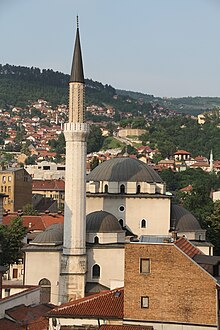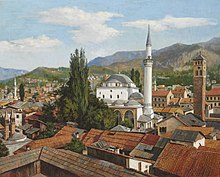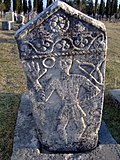
The Süleymaniye Mosque is an Ottoman imperial mosque located on the Third Hill of Istanbul, Turkey. The mosque was commissioned by Suleiman the Magnificent and designed by the imperial architect Mimar Sinan. An inscription specifies the foundation date as 1550 and the inauguration date as 1557, although work on the complex probably continued for a few years after this.

Sultanzade Gazi Husrev-beg was an Ottoman Bosnian sanjak-bey (governor) of the Sanjak of Bosnia in 1521–1525, 1526–1534, and 1536–1541. He was known for his successful conquests and campaigns to further Ottoman expansion into Croatia and Hungary. However, his most important legacy was major contribution to the improvement of the structural development of Sarajevo and its urban area. He ordered and financed construction of many important buildings there, and with his will bequeathed all his wealth into endowment for the construction and long-term support of religious and educational facilities and institutions, such as the Gazi Husrev-beg Mosque, and the Gazi Husrev-begova Medresa complex with a Gazi Husrev-beg Library, also known as Kuršumlija.
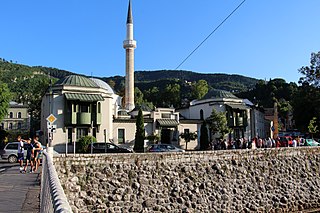
The Emperor's Mosque is an important landmark in Sarajevo, Bosnia and Herzegovina, being the first mosque to be built (1457) after the Ottoman conquest of Bosnia. It is the largest single-subdome mosque in Bosnia and Herzegovina, built in the classical Ottoman style of the era.

Türbe refers to a Muslim mausoleum, tomb or grave often in the Turkish-speaking areas and for the mausolea of Ottoman sultans, nobles and notables. A typical türbe is located in the grounds of a mosque or complex, often endowed by the deceased. However, some are more closely integrated into surrounding buildings.

Baščaršija is Sarajevo's old bazaar and the historical and cultural center of the city. Baščaršija was built in the 15th century when Isa-Beg Ishaković founded the city.
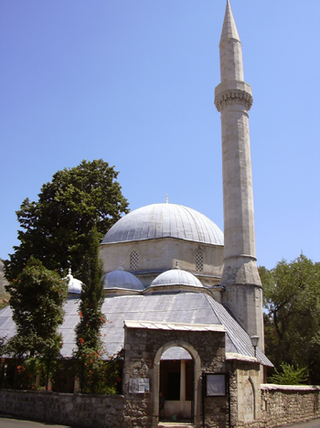
Karađoz Bey Mosque is a 16th-century Ottoman mosque in the city of Mostar, Bosnia and Herzegovina.

The Sanjak of Herzegovina was an Ottoman administrative unit established in 1470. The seat was in Foča until 1572 when it was moved to Taşlıca (Pljevlja). The sanjak was initially part of the Eyalet of Rumelia but was administrated into the Eyalet of Bosnia following its establishment in 1580.
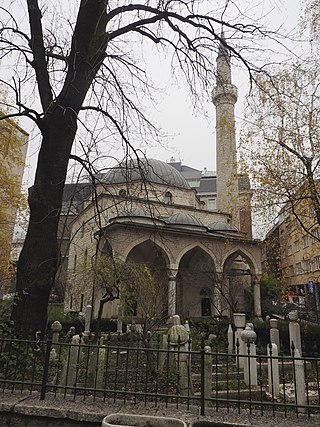
Ferhadija Mosque, also known as Ferhat Pasha Mosque, is a central building in the city of Sarajevo built by Bosnian Sanjak-bey (governor) Ferhad-beg Vuković, a descendant of the famous mediaeval Vuković family. This mosque has one dome above the prayer area and three small domes at the cloister and is one of the greatest achievements of Bosnia and Herzegovina’s 16th century Ottoman and Islamic architecture.
Hadım Sinan Pasha was a Bosnian-Ottoman nobleman, politician and statesman. He served as the Grand Vizier of the Ottoman Empire from 1516 to 1517. He was a eunuch.

Sanjak of Bosnia was one of the sanjaks of the Ottoman Empire established in 1463 when the lands conquered from the Bosnian Kingdom were transformed into a sanjak and Isa-Beg Isaković was appointed its first sanjakbey. In the period between 1463 and 1580 it was part of the Rumelia Eyalet. After the Bosnia Eyalet was established in 1580 the Bosnian Sanjak became its central province. Between 1864 and the Austro-Hungarian occupation of Bosnia in 1878 it was part of the Bosnia Vilayet that succeeded the Eyalet of Bosnia following administrative reforms in 1864 known as the "Vilayet Law". Although Bosnia Vilayet was officially still part of the Ottoman Empire until 1908 the Bosnian Sanjak de facto ceased to exist in 1878; when it was occupied by Austria-Hungary.
Murat Bey Tardić or Murat-beg Tardić was an Ottoman general.
The following is a timeline of the history of the city of Sarajevo, Bosnia and Herzegovina.

The Gazi-Husrev-beg Library is a public library in Sarajevo, Bosnia and Herzegovina founded in 1537 by the sanjakbey of Bosnia Gazi Husrev-beg during Ottoman rule, it is a part of the larger complex with the Gazi Husrev-beg Medresa. It holds one of the most important collections of Islamic manuscripts in Bosnia-Herzegovina, including many originally donated by Gazi Husrev-beg. The collection survived through Bosnian war and Siege of Sarajevo. The library also holds a sizable number of books, journals, newspapers, documents and photographs.
Feriz Beg was a 15th and 16th-century Ottoman military officer, Sanjak-bey of the Sanjak of Scutari and Sanjak of Bosnia.
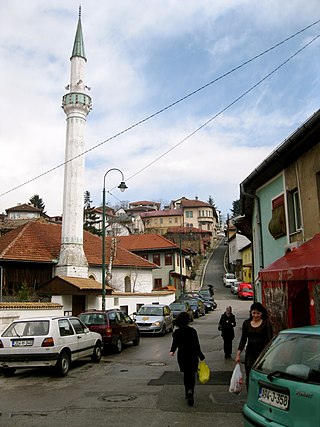
The Vekil-Harrach or Hadžijska mosque is a mosque in the city of Sarajevo, Bosnia and Herzegovina. It is located in Alifakovac, a neighborhood in Babića bašća local community, one of the oldest urban settlements in Sarajevo.

The Aladža Mosque, also known as Šarena džamija, "Colorful Mosque", is an Ottoman era mosque that was built in 1549 and located in Foča, Bosnia and Herzegovina. It is considered one of the most beautiful and important examples of Ottoman architecture in Europe, and is one of the most important Ottoman era mosques in all of Bosnia and Herzegovina; along with the Gazi Husrev-beg Mosque in Sarajevo and the Ferhadija Mosque in Banja Luka. It was completely destroyed with pre-planted explovises at the beginning of the Bosnian War in 1992 by the VRS, and levelled to the ground; along with the left over stones and rubble from the mosque being hidden all over Foča to prevent its reconstruction. After many years of searching for the stones once the Bosniak refugees of Foča began to return, and sourcing the funds necessary for the reconstruction of the mosque, its reconstruction was started in 2016, and completed in 2018.

Classical Ottoman architecture is a period in Ottoman architecture generally including the 16th and 17th centuries. The period is most strongly associated with the works of Mimar Sinan, who was Chief Court Architect under three sultans between 1538 and 1588. The start of the period also coincided with the long reign of Suleiman the Magnificent, which is recognized as the apogee of Ottoman political and cultural development, with extensive patronage in art and architecture by the sultan, his family, and his high-ranking officials.
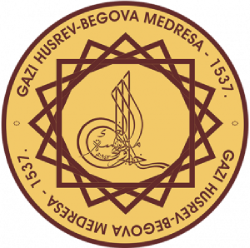
JU Gazi Husrev-begova medresa, Sarajevo is a high school and college, a madrasa in Arabic, founded on 8 January 1537 CE and built in Sarajevo as Gazi Husrev-beg's second endowment. It was built in the style of the Istanbul madrasas, and was called Kuršumlija because it was covered with a lead roof.

Gazi Husrev-beg's bezistan is one of the preserved bezistan in Sarajevo, Bosnia and Herzegovina, from the Ottoman period in the history of the country. Built in 1555 in Baščaršija, bezistan still serves its purpose - trade.

Gazi Husrev-beg's Hanikah is a hanikah in Sarajevo. Tesavuf was studied in hanikah, and today it has an artistic purpose.
